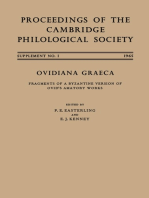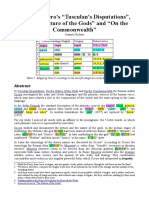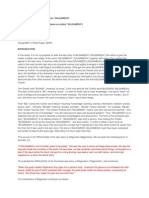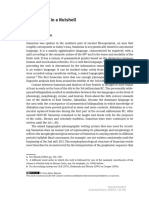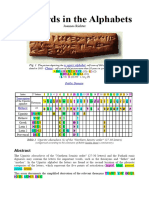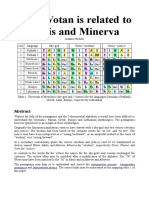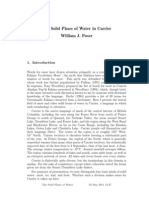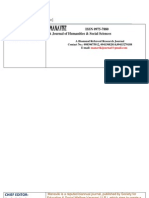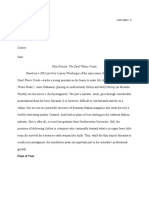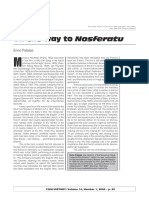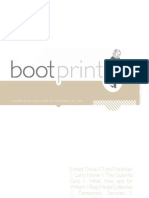Professional Documents
Culture Documents
The First Record of The Carrier Language
Uploaded by
Bill PoserOriginal Title
Copyright
Available Formats
Share this document
Did you find this document useful?
Is this content inappropriate?
Report this DocumentCopyright:
Available Formats
The First Record of The Carrier Language
Uploaded by
Bill PoserCopyright:
Available Formats
The First Record of the Carrier Language William J.
Poser
[This is a slightly modied version of a paper that appeared in volume 4 of
Working Papers in Athabaskan Linguistics ,
Alaska Native
Language Center, Fairbanks, Alaska, 2004.]
The rst record of the Carrier language is found in the journal of Alexander MacKenzie (MacKenzie 1801/1962), the leader of the party of Northwest Company men who rst crossed the continent, reaching the Pacic at Bella Coola. Most of the Carrier material recorded by MacKenzie takes the form of a vocabulary (p. 164) collected on June 22nd, 1793 while camped near what is now Alexandria reserve. These words are presumably in an Eastern Blackwater dialect, corresponding to those of the current Nazko and Red Blu bands. Here is MacKenzies Carrier vocabulary. The headwords are the words as he wrote them. These are followed by his gloss, the modern form in IPA, if discernible, and in some cases comments. nah eye /-na/ thigah hair /-tsia/ gough teeth /-u/ nenzeh nose /-nintsis/ thie head /-tsi/ dekin wood /dtn/ lah hand /-la/
kin leg /-ketn/. The modern form consists of /ke/ foot plus /tn/ stick. Either MacKenzie missed the rst syllable, or in this dialect of Carrier at this time stick was used uncompounded for leg. thoula tongue /-tsula/ zach ear /-dzoh/. MacKenzies transcription probably reects /dzx/, which is the expected earlier form of /dzoh/. dinay man /dne/ chiqoui woman Perhaps /tseku/. If this identication is correct, and if MacKenzie is correct in glossing the form as woman rather than women, it shows that the distinction between singular and plural nouns had already been lost in 1793. Most dialects of Carrier have distinct singular and plural forms only for nouns denoting people and dogs. In the Blackwater dialects, however, even this distinction has been lost, and the word that means both woman and women is /tseku/. In the other dialects woman is /tseke/, of which /tseku/ is the irregular plural. On the other hand, it is conceivable that this dialect still had the distinction between singular /tseke/ and plural /tseku/ when MacKenzie recorded it, and that MacKenzies <chiqoui> represents /tsekue/, a blend formed when a Carrier speaker started o with the plural form, then switched to the singular. zah beaver /tsa/ yezey elk /yezih/ sleing dog /li/. MacKenzies transcription presumably reects /l One might take the /. initial <sl> literally as /sl/, which occurs in the rst person singular possessive form, but in this case we would expect a nal /k/ since in all dialects the possessed stem is /lik/ or /lk/. Presumably MacKenzie would have heard the nal /k/ of a form like [sl but it is not out of the question that this form reects the 1s possessed form and k], that MacKenzie failed to hear the nal /k/. thidnu ground-hog. Unrecognizable. ground-hog is /dtni/ today. thlisitoh
iron /lztih/ This word is recognizable from the Stuart/Trembleur Lake dialect, where it meansiron, steel, metal, knife but is no longer in use in Southern dialects, including the Blackwater group, where the equivalent term is /tes/. coun re /kwn/ tou water /tu/ zeh stone /tse/ nettuny bow Perhaps /nelt/ our bows. This is currently /nelti/ and means our ries, but there is other evidence for the sound change involved (Story 1984) as well as the shift in meaning. igah arrow. Probably the verbless sentence / i ka/ it followed by arrow (which generally means rie cartridge today). nesi yes. Unrecognizable. yes is /a/ at present. thoughoud plains Perhaps /tlokt/. andezei come here. Unclear. come here is / anih/ at present. MacKenzies <andezei> may consist of / anih/ followed by something else, but the <d> remains to be accounted for. In addition to this vocabulary, MacKenzies journal contains several names of peoples and places. Since MacKenzie reports no contact with Carrier speakers prior to entering the region occupied by Blackwater speakers, these all evidently reect the Blackwater dialect group. Nagailer (p. 164), Nagailas (pl.) (p. 186) Carrier person. These probably reect /nkel-a/, with the /s/ of the second form the English plural sux. The modern term is /dakel/, which means those who go in boats on top of the water. As Goddard (1981:430) has suggested, the form recorded by MacKenzie is probably not exactly the same word but contains the prex /n/ around, in a loop in place of /da/ on top, together with the verb stem /kel/ go by boat. The nal /a/ recorded by MacKenzie is probably the human singular relativizing sux,
/n/ in the Stuart/Trembleur Lake dialect familiar from the literature, but /a/ in Southern Carrier. The modern term is a zero-nominalization. The use of a plain <l> for /l/ is notable, since Europeans generally did not know what to make of [l] but were aware that it was distinct from [l] and indicated the distinction in some manner. Unfortunately, we do not have other examples of MacKenzies transcription on the basis of which to judge, but in the much more extensive wordlist recorded by Daniel Harmon (Harmon 1820), with the Northwest Company in Carrier country from 1809-1819, although /l/ in the coda is written in various ways and not always distinguished from /l/, /l/ in the onset is almost invariably written <cl>. It is possible that MacKenzie actually heard [l], voiced from /l/ intervocalically. Atnah (p. 164) / tna/. Mackenzie uses this word in reference to Shuswap Indians. It is actually a word of more general usage, referring to any non-Athabaskan Indian. Anah-yoe Tesse (p. 207) Mackenzie uses this in reference to a river, either the Bella Coola River or one of its tributaries. The rst word may be a garbled version of / tnakoh/, the Carrier name for the Bella Coola River. Sloua-cuss-Dinais (p.198) Kluskus people. /luskztene/ or /luskzdne/. If the former, this consists of /luskz/ Kluskus Village /ten/ inhabitant and the human plural /ne/. If the it consists of /luskz/ plus /dne/ person. latter, Nascud Denee (p. 186) /nazkotene/ or /nazkodne/. The rst component is /nazko/ Nazko Village. The remainder is either /ten/ inhabitant and the human plural /ne/ or /dne/ person. Although MacKenzie was not able to transcribe very accurately, due to his lack of familiarity with the language, training in phonetics, and a standard phonetic notation, most of the words he recorded are recognizable. Indeed, they reveal a few details of the history of the language: a. His spelling of tree and leg shows that the Proto-Athabaskan velars had not yet become palatal aricates, as they soon thereafter did. b. His spelling of dog indicates that Carrier still had nasalized vowels. On the basis of comparison with the other Athabaskan languages Carrier must at some point in the past have had nasalized vowels, but it no longer does, and even records from the late nineteenth century dont show it. c. The fact that MacKenzie wrote <th> where older speakers of the current language have /ts/, as in hair, head, and tongue (but not, for some reason, stone), suggests that he heard an interdental aricate [t ]. Nowadays, older speakers contrast apico-alveolars with lamino-dentals. The distinction has been lost by younger speakers, who have merged the lamino-dentals with the apico-alveolars. The lamino-dentals were very likely once interdental, as their cognates are in some related languages.
One surprising feature of MacKenzies word list is that it gives the bare stems of the body parts: eye, hair, teeth, nose, head, hand, leg, tongue, ear. In Carrier as in the other Athabaskan languages, body parts, as well as kinship terms and a few other nouns, are inalienably possessed. The stems recorded by MacKenzie therefore never occur in isolation. MacKenzie never mentions engaging in any sort of morphological analysis, nor is there any evidence that he had any interest in linguistics, but either he extracted the stems or one of his Carrier informants had performed the same analysis on his own language and gave MacKenzie bare stems. Someone did a surprising bit of morphological analysis back in 1793.
References
Goddard, Ives (1981) Synonymy, pp. 430-431 of Margaret L. Tobey Carrier in June Helm (ed.) Handbook of North American Indians: Volume 6. Subarctic. Washington, DC: Smithsonian Institution, pp. 413-432. Harmon, Daniel Williams (1820) A Journal of Voyages and Travels in the Interior of North America. Edited by Daniel Haskel in 1820. Allerton Book Company, New York. 1922. Mackenzie, Alexander (1801/1962) Journal of the Voyage to the Pacic. Walter Sheppe, ed. Berkeley: University of California Press. Reprinted 1995 at New York by Dover. Story, Gillian L. (1984) Babine and Carrier Phonology: A Historically Oriented Study. Arlington, Texas: Summer Institute of Linguistics.
You might also like
- The Sur (Tapshin) language of Central Nigeria and its affinitiesDocument27 pagesThe Sur (Tapshin) language of Central Nigeria and its affinitiesxdboy2006No ratings yet
- A Periodic Table For Ugaritic Signaries As A Root For The Sky-God Dyaus and The Personal Pronouns For The 1st Person Singular and Dual FormDocument21 pagesA Periodic Table For Ugaritic Signaries As A Root For The Sky-God Dyaus and The Personal Pronouns For The 1st Person Singular and Dual FormRichter, JoannesNo ratings yet
- Teng WarDocument10 pagesTeng WarAristid HavlicekNo ratings yet
- 'Wrath!' Was The First Word - Hidden Symbols, Which We Never UnveiledDocument77 pages'Wrath!' Was The First Word - Hidden Symbols, Which We Never UnveiledRichter, JoannesNo ratings yet
- Understanding How Father Morice Wrote CarrierDocument5 pagesUnderstanding How Father Morice Wrote CarrierBill PoserNo ratings yet
- Ovidiana Graeca: Fragments of a Byzantine Version of Ovid's Amatory WorksFrom EverandOvidiana Graeca: Fragments of a Byzantine Version of Ovid's Amatory WorksNo ratings yet
- The First Germanic Consonant ShiftDocument5 pagesThe First Germanic Consonant ShiftMilena LakićevićNo ratings yet
- PSychoyos Semiotica LibreDocument68 pagesPSychoyos Semiotica Librebu1969No ratings yet
- Relativistic Electrodynamics PDFDocument10 pagesRelativistic Electrodynamics PDFMizanur RahmanNo ratings yet
- Encoding The Precession Period-Constants in The OdysseyDocument33 pagesEncoding The Precession Period-Constants in The OdysseyRichter, JoannesNo ratings yet
- What Is Entropic PoetryDocument9 pagesWhat Is Entropic PoetryÖzcan TürkmenNo ratings yet
- Malapert rocks provide concise meaningsDocument6 pagesMalapert rocks provide concise meaningshendrix obcianaNo ratings yet
- IRK BİTİG iNGİLİZCE PDFDocument70 pagesIRK BİTİG iNGİLİZCE PDFİsmail EmirşahNo ratings yet
- NTSE Series Completion Test GuideDocument35 pagesNTSE Series Completion Test GuideShivam GoyalNo ratings yet
- 4 Cry PaDocument28 pages4 Cry PaVenkata AppajiNo ratings yet
- Where The Devil Is Hell? by Doug MitchellDocument20 pagesWhere The Devil Is Hell? by Doug MitchellTrent Riffin WildeNo ratings yet
- Pages From Emmons Tlingit 1Document37 pagesPages From Emmons Tlingit 1Anonymous RpAgOsOr100% (1)
- The Role of The Southern Semitic Order in The Ugaritic SignariesDocument16 pagesThe Role of The Southern Semitic Order in The Ugaritic SignariesRichter, JoannesNo ratings yet
- Electrolysis Cryptogram With AnswersDocument6 pagesElectrolysis Cryptogram With AnswersoscarbecNo ratings yet
- Avesta ZazakiDocument85 pagesAvesta ZazakiHavadise Zazayan0% (1)
- Three Elusive Amulets from AntiquityDocument27 pagesThree Elusive Amulets from AntiquitymabdelpassetNo ratings yet
- DevarimDocument7 pagesDevarimDavid MathewsNo ratings yet
- OghamDocument7 pagesOghamuomomedicina.itNo ratings yet
- Syriac Alphabet - WikipediaDocument10 pagesSyriac Alphabet - WikipediaGabNo ratings yet
- Ancient Hebrew Calendar-Template - PDFDocument1 pageAncient Hebrew Calendar-Template - PDFYosiah YedidiahNo ratings yet
- Astronomical - Observatories Cultural - HeritageDocument380 pagesAstronomical - Observatories Cultural - HeritagebblumenbergNo ratings yet
- Qumran Hebrew Compared To Biblical HebreDocument4 pagesQumran Hebrew Compared To Biblical HebreAlexandre Rocha Lima e MarcondesNo ratings yet
- The Origin of Some Personal Pronouns of The 1st Person SingularDocument15 pagesThe Origin of Some Personal Pronouns of The 1st Person SingularRichter, JoannesNo ratings yet
- Notes To Cicero's Tusculan Disputations, On The Nature of The Gods, On The CommonwealthDocument50 pagesNotes To Cicero's Tusculan Disputations, On The Nature of The Gods, On The CommonwealthRichter, JoannesNo ratings yet
- Sumerian/ Babylonian Measures of CapacityDocument15 pagesSumerian/ Babylonian Measures of CapacitymohanNo ratings yet
- A New Understanding of The Name So-Called - GilgameshDocument21 pagesA New Understanding of The Name So-Called - GilgameshHakki YazganNo ratings yet
- Papyrus 4 Image and DescriptionDocument7 pagesPapyrus 4 Image and DescriptionChristianPubillPiñero100% (1)
- The Sumerian and Ural-Altaic Elements in The Old Slavic Language - Csőke SándorDocument71 pagesThe Sumerian and Ural-Altaic Elements in The Old Slavic Language - Csőke SándorTarqwinNo ratings yet
- An Architecture For The PIE-LanguagesDocument32 pagesAn Architecture For The PIE-LanguagesRichter, JoannesNo ratings yet
- The Cherokee Alphabet or SyllabaryDocument5 pagesThe Cherokee Alphabet or SyllabaryMichael H ChristensenNo ratings yet
- Use-Of OT-in NTDocument33 pagesUse-Of OT-in NTsorin71100% (1)
- The Mystery of The Hebrew Language AppendixDocument17 pagesThe Mystery of The Hebrew Language AppendixJOSINEE KAREMERANo ratings yet
- Analysis of DAT ROSA MEL APIBUS Painting by John EberlyDocument3 pagesAnalysis of DAT ROSA MEL APIBUS Painting by John EberlyvfallikNo ratings yet
- Mari Dreams - by Jack SassonDocument12 pagesMari Dreams - by Jack SassonRupert840% (1)
- Singular Plural Nom. Obl. Nom. OblDocument4 pagesSingular Plural Nom. Obl. Nom. ObltrapezundNo ratings yet
- Greek Handwriting - Handwritten Greek Letters - How To Handwrite in GreekDocument4 pagesGreek Handwriting - Handwritten Greek Letters - How To Handwrite in Greeknilton.estevesNo ratings yet
- Nguna: A Brief Grammar Sketch: Masahiko NoseDocument9 pagesNguna: A Brief Grammar Sketch: Masahiko NoseMasahiko Nose100% (1)
- Categorized Overview of The PentagramsDocument40 pagesCategorized Overview of The PentagramsRichter, JoannesNo ratings yet
- Sumerian in A NutshellDocument13 pagesSumerian in A NutshellPablo Carrión ARGNo ratings yet
- A Headless PillarDocument7 pagesA Headless PillarDAVIDNSBENNETTNo ratings yet
- The Testament of Lazarus: The Pre-Christian Gospel of John (Janet Tyson, Pirištu Books, 2023)Document171 pagesThe Testament of Lazarus: The Pre-Christian Gospel of John (Janet Tyson, Pirištu Books, 2023)JanetNo ratings yet
- Restoring The Lost History of The Priests From Scripture and JosephusDocument15 pagesRestoring The Lost History of The Priests From Scripture and Josephusapi-204785694No ratings yet
- Dragon languagesDocument3 pagesDragon languages0114paolNo ratings yet
- Ayturk - Turkish Linguists Against The WestDocument26 pagesAyturk - Turkish Linguists Against The WestS.K. RoyNo ratings yet
- Baal HaSulam - 4 - Talmud Eser Sefirot (Book of The 10 Spheres)Document55 pagesBaal HaSulam - 4 - Talmud Eser Sefirot (Book of The 10 Spheres)nicolaswrobelNo ratings yet
- The History of Designing An AlphabetDocument9 pagesThe History of Designing An AlphabetRichter, JoannesNo ratings yet
- Basic English and Grammatical Reform, 1937, C.K. OgdenDocument25 pagesBasic English and Grammatical Reform, 1937, C.K. OgdenArslankhan83100% (1)
- The Parallel New Testament Gree - Scrivener, Frederick Henry AmbrDocument1,140 pagesThe Parallel New Testament Gree - Scrivener, Frederick Henry AmbrCesarNo ratings yet
- Keywords in The AlphabetsDocument21 pagesKeywords in The AlphabetsRichter, JoannesNo ratings yet
- Biblical Abbreviations and TermsDocument1,750 pagesBiblical Abbreviations and TermsBrian Berge100% (2)
- Why Wotan Is Related To Metis and Minerva...Document16 pagesWhy Wotan Is Related To Metis and Minerva...Richter, JoannesNo ratings yet
- English Dialects From the Eighth Century to the Present DayFrom EverandEnglish Dialects From the Eighth Century to the Present DayNo ratings yet
- D-Effect Related Phenomena in Southern DakelhDocument12 pagesD-Effect Related Phenomena in Southern DakelhBill PoserNo ratings yet
- Understanding How Father Morice Wrote CarrierDocument5 pagesUnderstanding How Father Morice Wrote CarrierBill PoserNo ratings yet
- Understanding Aboriginal GovernmentDocument3 pagesUnderstanding Aboriginal GovernmentBill PoserNo ratings yet
- Solid WaterDocument5 pagesSolid WaterBill PoserNo ratings yet
- Creative Pencil Drawing PDFDocument168 pagesCreative Pencil Drawing PDFsalman 'D' amonNo ratings yet
- Office of The District and Sessions Judge, Ludhiana.: Public NoticeDocument3 pagesOffice of The District and Sessions Judge, Ludhiana.: Public NoticeJeshiNo ratings yet
- S03-22 The Rats of Round Mountain, Part II Pagoda of The RatDocument27 pagesS03-22 The Rats of Round Mountain, Part II Pagoda of The RatKaleb Gleason100% (3)
- Copyreading Duties and ProceduresDocument59 pagesCopyreading Duties and ProceduresStephanie100% (1)
- 1 As Scientific Stream Yearly PlanningDocument4 pages1 As Scientific Stream Yearly PlanningRihabSallamNo ratings yet
- Catalog On The AR-15 RifleDocument100 pagesCatalog On The AR-15 RifleBergerudR100% (1)
- (OCR) Sir Thomas Phillipps - The Horblit Collection of The Middle Hill PressDocument233 pages(OCR) Sir Thomas Phillipps - The Horblit Collection of The Middle Hill PressorestesbrownsonNo ratings yet
- Chicago Manual of StyleDocument1 pageChicago Manual of Stylecontrax8No ratings yet
- Employee Engagement Practices in Hindustan Times: A Project Report ONDocument93 pagesEmployee Engagement Practices in Hindustan Times: A Project Report ONRakesh Sharma100% (1)
- Deep and Surface Structure and AmbiguityDocument11 pagesDeep and Surface Structure and AmbiguityLogi CheminotNo ratings yet
- Leading Print Newspapers U.S. by Circulation 2023 - StatistaDocument4 pagesLeading Print Newspapers U.S. by Circulation 2023 - Statistajulyanlp12No ratings yet
- About ManavikiDocument4 pagesAbout ManavikimanavikijournalNo ratings yet
- Group 8 Political CaricaturesDocument25 pagesGroup 8 Political CaricaturesJericho Velchez86% (7)
- En4Ss-Iiic-1.4: "Big Feet-Big Heart" Adapted From Chicken Soup For The Soul by Jack Canfield and Mark HanselDocument4 pagesEn4Ss-Iiic-1.4: "Big Feet-Big Heart" Adapted From Chicken Soup For The Soul by Jack Canfield and Mark HanselmarifeNo ratings yet
- How Do Philippine Languages WorkDocument41 pagesHow Do Philippine Languages WorkChem R. PantorillaNo ratings yet
- Devil Wears PradaDocument7 pagesDevil Wears PradaMahreen MalikNo ratings yet
- Istorija FilmaDocument7 pagesIstorija Filmabojannesovic2No ratings yet
- Features New To This Edition: SketchbookDocument49 pagesFeatures New To This Edition: SketchbookBuduganLoredana79% (97)
- December 2, 2015 Tribune-PhonographDocument16 pagesDecember 2, 2015 Tribune-PhonographcwmediaNo ratings yet
- Boot Print Volume 3/issue 1 - Summer 2009Document32 pagesBoot Print Volume 3/issue 1 - Summer 2009Georgia KotretsosNo ratings yet
- WHat Is Position PaperDocument2 pagesWHat Is Position PaperTalalNo ratings yet
- LansingStateJournal 201705141Document75 pagesLansingStateJournal 201705141Joanne J. StevensNo ratings yet
- (Cambridge Library Collection - History of Printing, Publishing and Libraries) John Southward-Dictionary of Typography and Its Accessory Arts-Cambridge University Press (2010)Document196 pages(Cambridge Library Collection - History of Printing, Publishing and Libraries) John Southward-Dictionary of Typography and Its Accessory Arts-Cambridge University Press (2010)Ángel Quintero SánchezNo ratings yet
- The Eclipse of The Countertenor Voice, by FoxDocument41 pagesThe Eclipse of The Countertenor Voice, by FoxDavid FielNo ratings yet
- The World Is Not EnoughDocument15 pagesThe World Is Not Enoughaquel1983No ratings yet
- TM - 9 1005 222 12 - 17mar1969Document67 pagesTM - 9 1005 222 12 - 17mar1969lobosolitariobe100% (1)
- How We Select PartnersDocument26 pagesHow We Select Partnerselenamarin1987No ratings yet
- Call of Duty - Black OpsDocument24 pagesCall of Duty - Black OpsKarneNo ratings yet
- Методичка для студентовDocument19 pagesМетодичка для студентовYekaterinaVlasenkoNo ratings yet
- In The Loop 3 - U4 PDFDocument16 pagesIn The Loop 3 - U4 PDFadrianmaiarotaNo ratings yet






